Hove to in the gales of Biscay
John Kretschmer needed his full kit of storm sailing tactics to get through a fraught passage across the famously nasty bay
I first downloaded the American GFS weather model, and it didn’t look good. I tried the ECMWF European model, but it was worse. I even downloaded the German ICON model, but no matter how many ways I crunched the data, the GRIB files refused to yield. I closed my eyes and meditated, I hummed Gregorian chants, I even turned the iPad off and restarted it, but there was just no willing away the procession of deep low-pressure systems marauding across the Bay of Biscay. Gales and strong head winds were forecast for at least a week and possibly longer. We were going to get rocked and I had a sense of dejá vu.
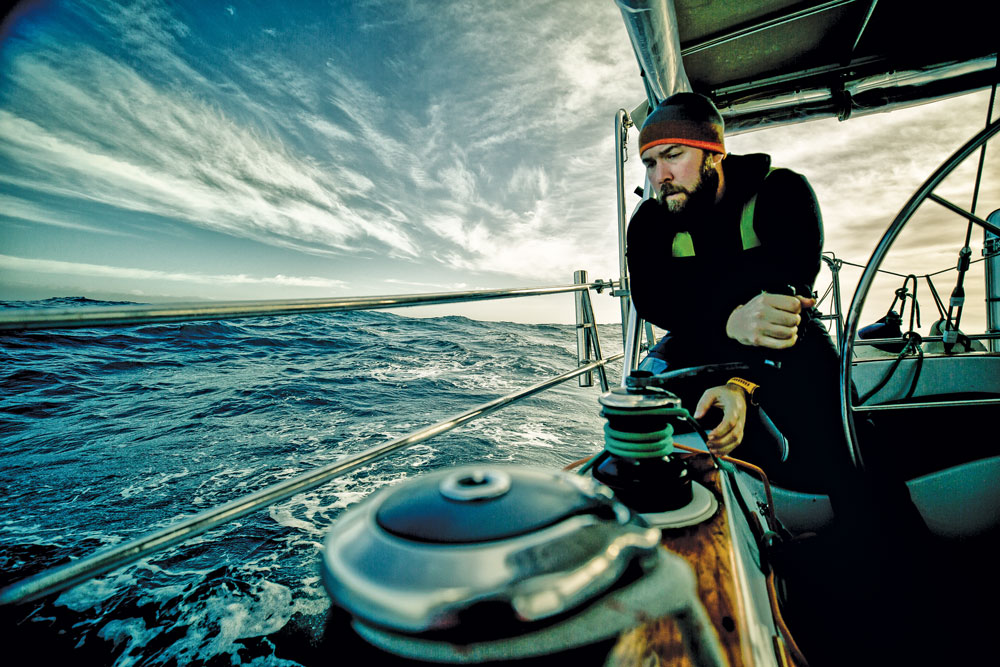
Quetzal was nestled in Lymington Yacht Haven, just off the Solent along the south coast of England. It was a fitting spot for a short but well-earned break. We had recently completed a challenging Atlantic crossing by way of the far north, retracing the route of the Vikings, albeit in reverse and nosing above the Arctic Circle. I chose Lymington because it was where we first launched Gigi, the Contessa 32 sloop that I sailed around Cape Horn 39 years ago. It was also a poignant stop, as my friend Jeremy Rogers, the legendary founder of Contessa Yachts, had recently passed away after a long illness. My wife Tadji and I had dinner with Jeremy’s family and remembered his remarkable career as a sailor, boatbuilder, husband, father and grandfather. We toasted a life well lived.
My new crew arrived a few days later and Tadji had the good sense to return to our pied-à-terre in Paris, which serves as our home base these days. It was late October and time to sail south. We were bound for Cadiz, Spain, just west of the Straits of Gibraltar, a 1,200-mile nonstop passage across the Bay of Biscay and skirting the Iberian Peninsula. Studying the grim forecast, I remembered the trials of trying to coax Gigi out of the English Channel. I was a slightly terrified but game 23-year-old captain. I sailed with Gigi’s owner, Ty Techera, who was a complete novice but the hardiest of shipmates and he taught his young skipper the power of perseverance. We shoved off despite a dreadful forecast and endured a long, cold, soaking week pounding into relentless southwesterly gales.
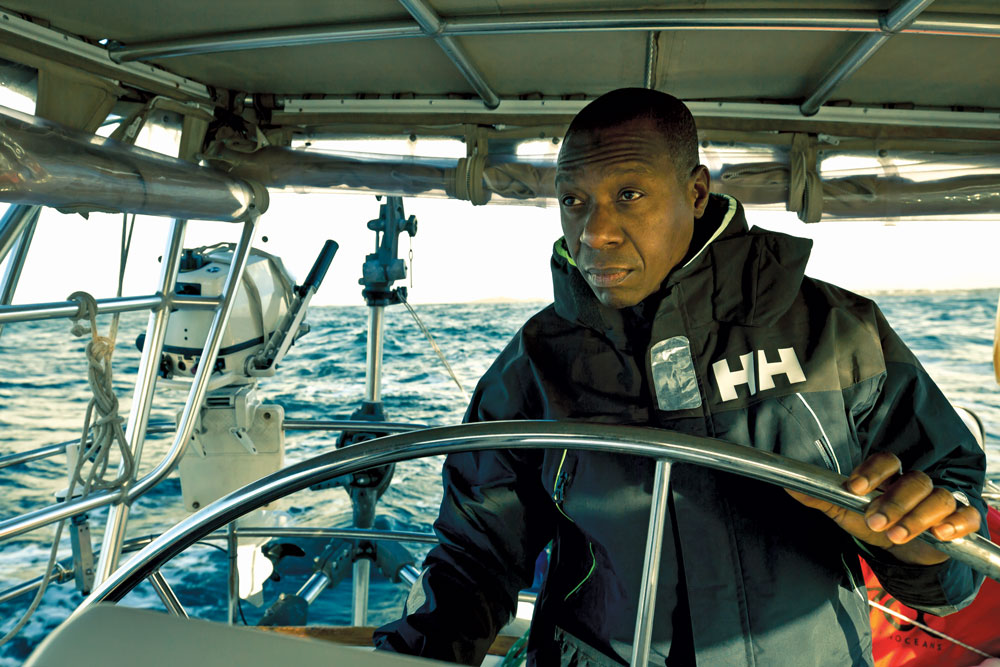
When we finally reached the Bay of Biscay, we were greeted by a Force 10 storm. Hello! It was a learning experience, to put it mildly, and would serve me well over the years as I became something of a specialist at stumbling into and out of heavy weather. In addition to trying out storm strategies I’d only read about, I discovered something just as important. If you are in a good boat and can find the right state of mind, it is a privilege to have a front row seat when nature is in a bad mood.
Back to 2022, I had dubbed this sail a “heavy weather training passage” and for some macabre reason the promise of misery is irresistible, even priceless, and it sold out quickly. Sometimes the weather doesn’t cooperate, and heavy weather passages go smoothly. This time, my crew, Andrew, Nickie, Roger and PJ, could not accuse me of overhype—they got their money’s worth.
We pushed off early to catch the current ebbing through Needles Channel. Once into the English Channel we made our way past the notorious tidal rip at Portland Bill, grateful for a 3-knot boost. The wind was reasonable, 20 to 25 knots from the south, and we zoomed along on a sweet close reach. A huge low-pressure system south of us was stalled, so we seized the opportunity to make as much westing as possible. Thirty hours, and 200 miles out of Lymington, we dodged the low and ducked into the Isles of Scilly with Nickie at the helm.
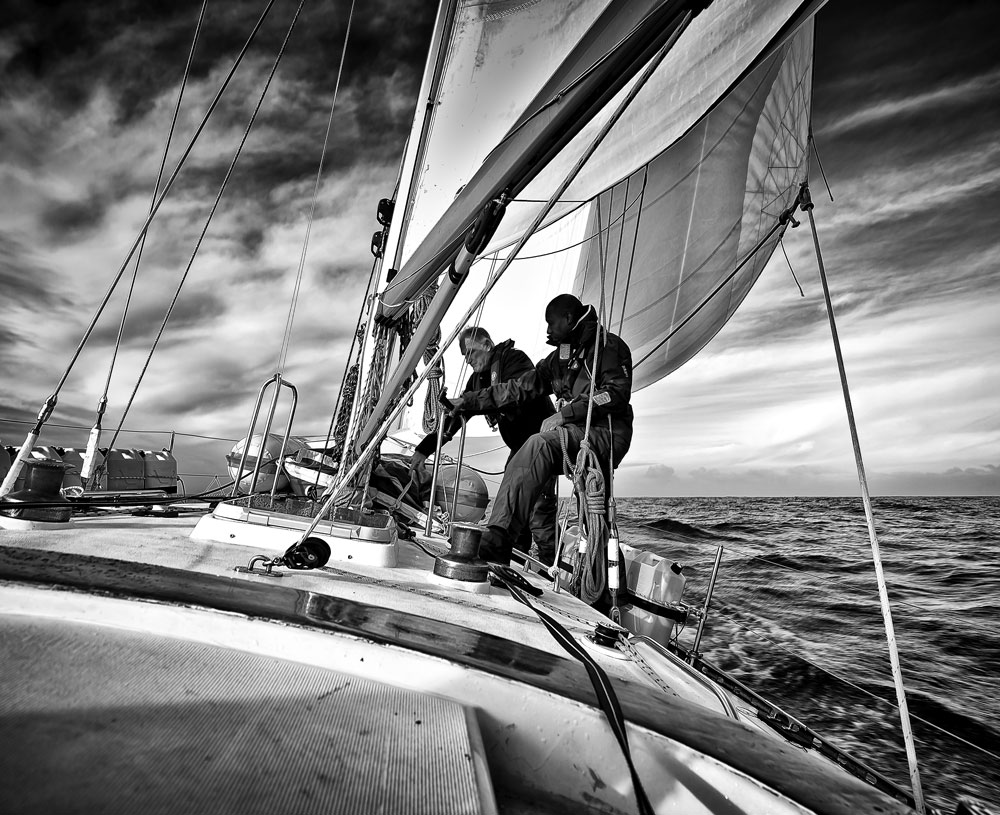
I didn’t need much of an excuse to detour to the Isles of Scilly and not just because they have a great name. A cluster of rocks and small islands just off the Cornwall coast, they’re touted as England’s tropical islands. Hmm? The water is blueish when the sun is just right, and the beaches are, well, a mix of sand and rock, but tropical? That’s a stretch. Brooding and windswept, the isles are enchanting in their own, English kind of way and also the setting for one of the country’s greatest maritime disasters. In 1707, the English fleet was returning from the Mediterranean under the command of Admiral Sir Cloudesley Shovell, a name you can’t make up. Unfortunately, Sir Cloudesley underestimated his latitude and his flagship piled up on the rocks. Four other ships of the line followed the admiral to their doom and nearly 2,000 sailors died. A story that just won’t go away claims that a local Scilly islander aboard the flagship tried to warn the admiral that they were approaching the islands. Insulted, Sir Cloudesley had him hung for impudence just before the ships barreled ashore. Supposedly, Sir Cloudesley survived the wreck and floated onto a beach where a local woman found him, bashed his head in with a rock and swiped his fancy rings. Thirty years later she confessed the crime on her deathbed.
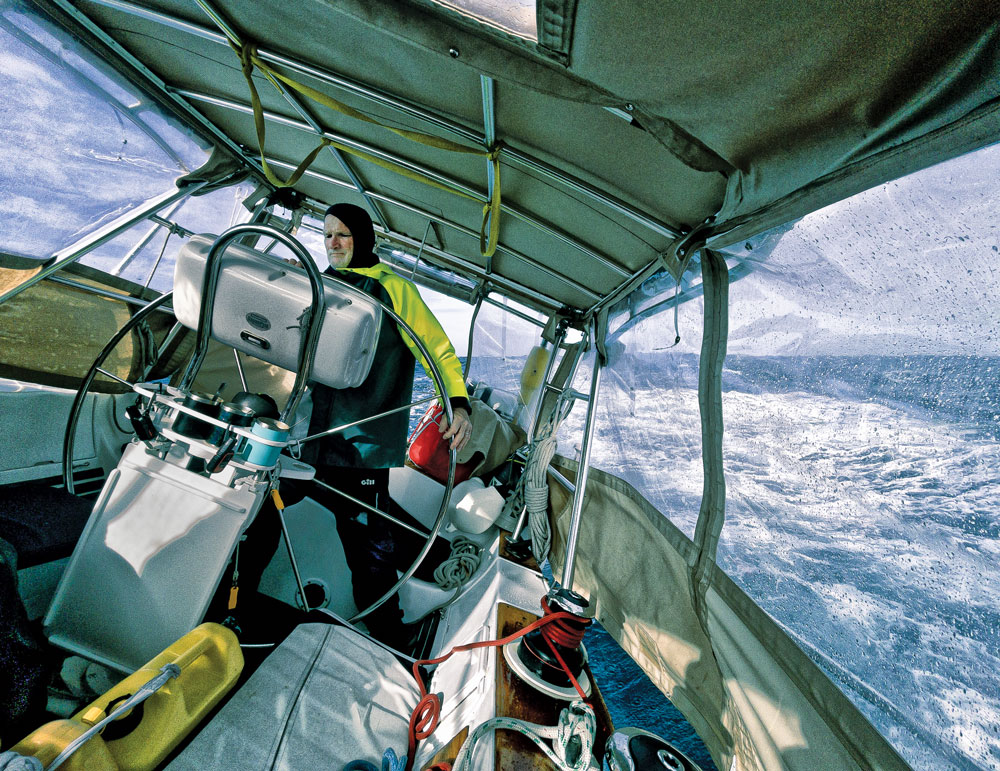
We were away at first light, trying and failing to lay the rhumbline toward Cape Finisterre. Strong southwest winds filled in behind the low, leaving us with two lousy choices, head due west for the open Atlantic south of Ireland, or aim toward Ile de Quessant, at the northeast corner of the Bay of Biscay. Quessant, which the Brits call “Ushant” just to irk the French, is the notorious island with a weathered lighthouse that’s always pictured on calendars with monster waves washing over it.
Although we were making decent progress tacking every four hours, the forecast called for southwest winds steady at 30 to 35 knots, with gusts to 45 knots, and seas to 20 feet. We had a 24-hour window to make our way past Quessant into Brest, a well-protected harbor on the northwest Brittany coast. It was a fateful decision and in hindsight probably a mistake. We would spend four challenging days trying to pound our way across Biscay.
The Bay of Biscay has a nasty reputation and for the most part it’s not deserved. In the summer, Biscay is a great sailing area rimmed with good harbors and French restaurants. But most sailors wait until the fall to leave Northern Europe on their way to the Med or Canary Islands, when the weather is less settled. A combination of prevailing southwest winds that amp up in the fall, low-pressure systems that track farther south, and raucous waves caused by abrupt depth changes where the continental shelf slices across the northern bay, can make for challenging sailing. Turning south-southeast, we gave up our precious westing and after an overnight sail secured Quetzal in the huge Marina du Chateau. We were thankful for floating pontoons; Brest harbor has a tidal range of nearly 25 feet.
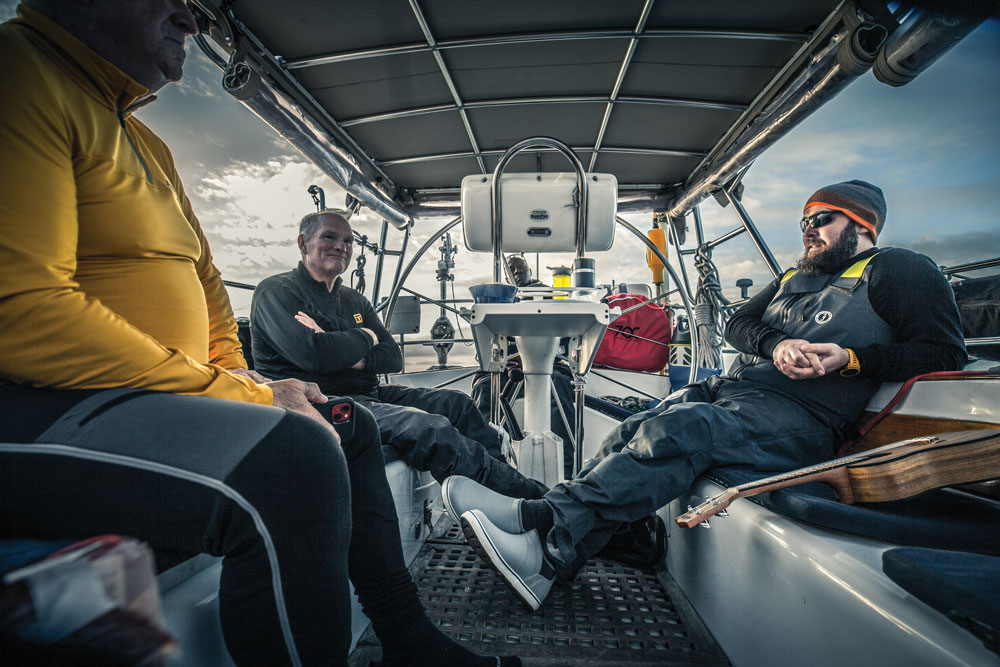
After a nice dinner ashore, and a busy morning of stocking up on essential French rations including red wine, fresh baguettes, dijon, and the piece de resistance of offshore provisions, aux cristol de sel (French butter with salt crystals,) we shoved off, once again bound for Cadiz.
This time we not only had gales on our minds, but also orcas. For the past three years sailboats have been targets of a prowling pod of orcas that roam from Gibraltar to the Bay of Biscay. While it’s hard to know just how many boats have had encounters, it is in the hundreds. The orcas typically go after the rudder and many boats have had to limp or be towed into port. By all accounts it’s terrifying when three-ton orcas ram the hull and take chunks out of, or completely break off, the rudder. Two boats have been sunk, including a 39-foot Beneteau on November 1, 2022. PJ and Roger thought they heard orcas off the stern during their night watch on our approach to Brest but fortunately they didn’t come for a visit.
All through the day of October 26 we shortened sail and by nightfall we were down to a triple-reefed main and staysail. Quetzal was nicely balanced, and we punched out 6 knots sailing close to the wind, pushing through one squall after another. At first light we were 30 miles from deep water where we hoped the seas would be longer and more regular. The passage across the continental shelf was wild with breaking waves charging at us from all directions. I was below, making breakfast, and suggested that we fall off the wind to ease the motion. Andrew and PJ were in the cockpit and questioned the strategy. “We will be taking the seas on the beam, is that OK?” PJ asked. “Just for a bit,” I replied, “it will be fine.” Sixty seconds after my reassurance, a steep wave smacked us just forward of the beam, breaking over the deck and twisting the stainless pipe between the stanchions that secured the spare fuel jerry cans into a pretzel. The jerry cans flopped across the foredeck, and we scrambled to retrieve them and lash them in the cockpit. The wave also cracked the Lexan portlight just above the galley creating a steady leak over the stove.
In addition to downloading GRIB files, licking my index finger and holding it into the wind, and peering knowingly at the swirling clouds, I was also in communication with my brother-in-law, Trevor Richards, who runs Star Weather
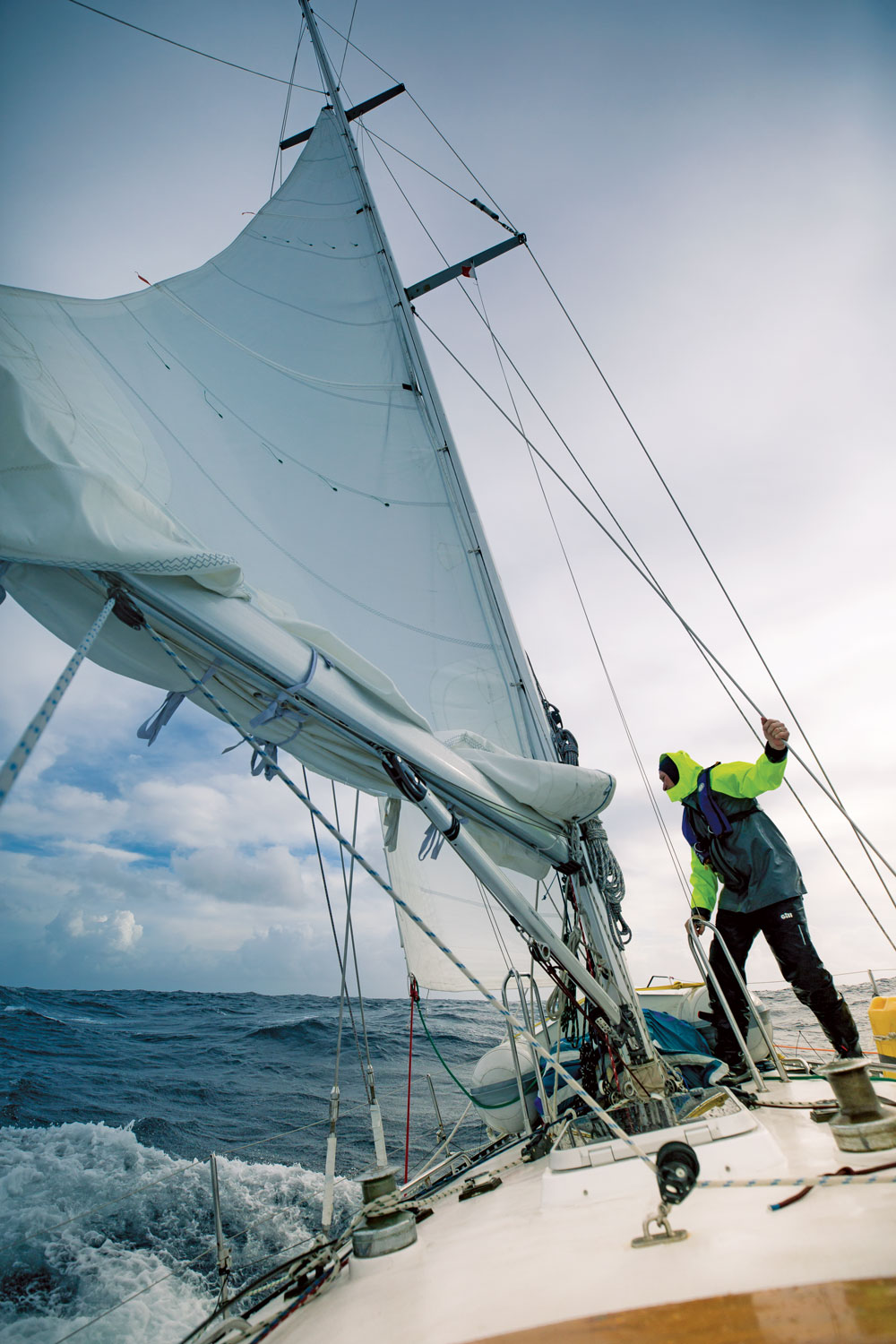
Routing. The forecast, which looked most unpleasant but manageable when we left Brest, now called for winds steady at 40 knots, gusting to 50, right on the nose, of course. “It’s going to get ugly,” Trevor texted via the Iridium sat phone, adding, “you might consider heaving to.” When I replied that was our plan, he responded reassuringly, “better you than me.”
We needed to make our way farther offshore because once hove to we would drift back toward the continental shelf. We partially furled the staysail, gritted our teeth and forereached into the rapidly building wind. Fifty miles off the shelf we brought the boat into the wind, backing the staysail and lashed the wheel to leeward. We rode about 60 degrees off the wind and the natural slick to windward caused by the boat’s hove to motion prevented any waves from washing on deck. While long keels and skeg rudders are out of fashion these days, the ability to heave to, to “turn off” the wind and take a break is a seamanship option not available to those in more modern hull shapes.
Eight hours later the wind backed to the south and we seized the opportunity to claw our way southwest. We went back to forereaching on port tack and made slow but steady progress. Andrew’s log entry summed up the conditions: “Gusts to 44 knots, triple-reefed main, tiny staysail, splashy.” We stuck to our watch system of three hours on and six off throughout the passage. Roger and PJ were a team, Andrew and Nickie another, and I had a solo watch. The hard dodger and full enclosure made standing watch dramatically less trying than if we were fully exposed to the elements. I had a nervous moment on my watch when I heard what clearly sounded like whales breathing off the stern. I started the engine and motored hard astern, creating a horrible motion but one that supposedly keeps orcas away from the rudder. After a few minutes I throttled back to neutral and shut down the engine. I scanned the dark horizon but couldn’t see anything but breaking waves. Hoping for the best, we carried on.

The wind dropped to 30 knots on the third day out of Brest but continued to blow from the southwest. It was becoming clear that we were not going to make Cadiz, or even Lisbon, in time for pre-arranged flights, and we began to consider an alternate landfall. We had another scare that morning when the autopilot quit. Pulling gear out of the lazarette to inspect the drive unit, I was shocked to see that the steering cables were loose. A close inspection also revealed that the autopilot linear drive had sheered the bolt connecting it to the quadrant. I spent a few hours squeezed into the lazarette, not a pleasant spot in lumpy seas, and eventually put the steering system and autopilot back together. We wondered if we may have had an orca encounter after all before concluding that it was more likely just the result of crashing off a nasty wave.
Reluctantly, we decided to make for A’Coruna, a deep, natural harbor on the dramatic northwest coast of Spain. We beat through the night and at first light on November 30, we were 60 miles north of A’Coruna. We were ready for a break and eased out more sail. Roger, the most experienced sailor among the crew, conned Quetzal to windward for hours. The wind dropped to 20 knots as we closed the coast and, naturally, headed us. We fired up the engine, and without a trace of guilt motorsailed the last 40 miles. We pulled into a slip at A’Coruna Marina four days out of Brest, eight days and 700 miles out Lymington. That night, in a dry, warm café, we toasted the gales of Biscay.

Comments